How To Access Remote Folder In Windows
Connecting to (a.k.a. mapping) network drives allows University members to access files stored on University servers. Storing files on network drives provides a user more storage space, backups of their files, and secure ways of sharing files betwixt departments.
Considerations when mapping a network bulldoze:
- In order to map a network drive, users must exist granted permission by their section or supervisor to access the textile. If a user is in need of permissions, supervisors or departments can submit a Departmental Data Storage request form.
- Due to HIPAA compliance, AHC drive mappings are non typically permitted.
Mapping a network bulldoze
- Windows 10
- Mac OSX
Mapping a network bulldoze in Windows 10
- Connect to Split Tunnel or Total Tunnel VPN if off campus.
- Click the First menu.
- Click File Explorer.
- Click This PC in the left side shortcut card.
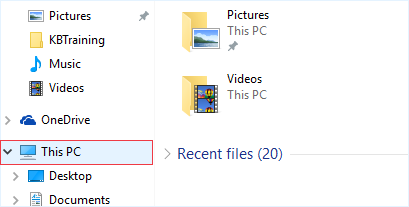
- Click Computer > Map network drive > Map network drive to enter Mapping wizard.

- Confirm drive letter to employ (next available shows up by default).
- Enter the server path for the network binder (e.chiliad. \\files.umn.edu\NAME\FOLDER, or \\files.umn.edu\OIT\Subfolder).
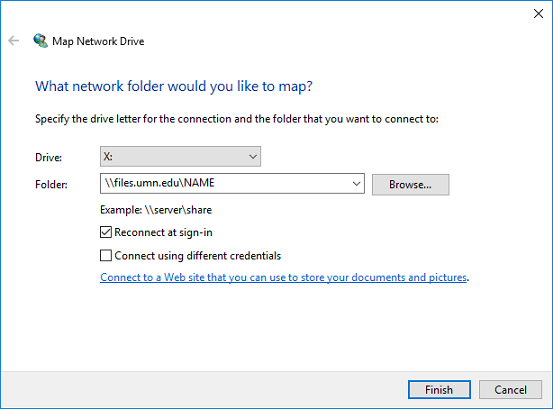
- Used letters are followed by server paths in parentheses.
- Tip: Select Reconnect at sign-in to connect this drive every time Windows starts.
- Select Connect using different credentials if using a computer that is not University-endemic.
- Enter ad.umn.edu\your Internet ID and password when prompted.
- Or, you can use [electronic mail protected]
- Not certain if your computer is University-owned?
- Cheque the computer name.
- Academy-owned machines typically accept names that start with UMN or end with .advertizement.umn.edu.
- Enter ad.umn.edu\your Internet ID and password when prompted.
- Click Finish at the bottom of the window.
- Find the network drive located in the Network locations department of This PC.

Mapping a shared folder in Mac OS X
- Connect to Split Tunnel or Total Tunnel VPN if off campus.
- Click Finder in the Dock.

- Find Become in the top card bar.
- Click Connect to Server€¦ (Œ˜+Grand).

- Type cifs: + the network drive path (east.k. cifs://files.umn.edu/OIT).
- Note: Your section may give y'all the path as \\files.umn.edu\Name, but Mac paths use forward slashes, not backslashes.
- Trysmb : + network drive path if cifs: does non work.
- Tip: Click the + push button to save frequently used network bulldoze paths for future use.
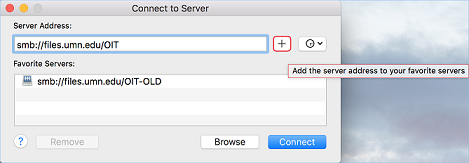
- Type AD\ + your Internet ID and your password if prompted.
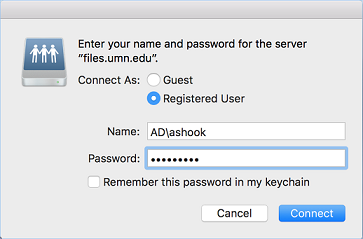
- Notation: Use a backslash (\), not a forward slash (/). Use AD\ if computer is not spring to the Advertizing. Use your Internet ID merely if the computer is spring to the AD.
- Alternately, you lot can use [e-mail protected]
- Notation: Use a backslash (\), not a forward slash (/). Use AD\ if computer is not spring to the Advertizing. Use your Internet ID merely if the computer is spring to the AD.
- Click Connect.
- To navigate back to your network drive share.
- Click Finder.
- Click files.umn.edu under Shared in the left mitt Finder menu.
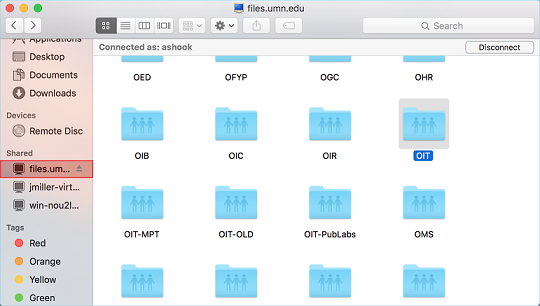
- Navigate to the folder that was shared with y'all.
- Notation: While all of the folders in files.umn.edu are visible, you can only encounter the contents of folders specifically shared with y'all.
- To navigate back to your network drive share.
Source: https://it.umn.edu/services-technologies/how-tos/connect-shared-drive-or-network-folder
Posted by: wilsonfole1966.blogspot.com

0 Response to "How To Access Remote Folder In Windows"
Post a Comment